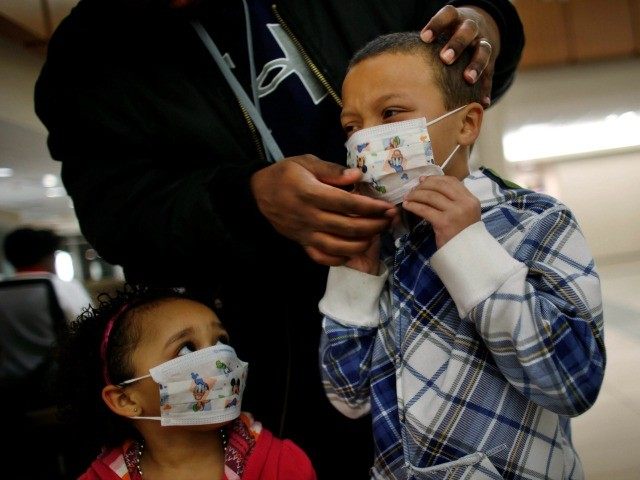The Centers for Disease Control declared a flu epidemic this week, as the death toll from “influenza-like” complications rose to 15 children. The flu season began early—part of a troubling pattern stretching back across several years—and the current strain seems resistant to commonly available vaccines.
Doctors emphasize the importance of beginning antiviral treatments as quickly as possible after symptoms manifest, particularly for children, the elderly, and people with weakened immune systems.
Let’s cut to the chase: some are wondering if this exceptionally bad flu season, arriving hard on the heels of the mysterious EV-D68 viral outbreak that claimed a number of young lives in the fall, has some connection to the massive influx of illegal aliens from Central America.
EV-D68 was virtually unknown in the United States until now, but as reporter Sharyl Attkisson noted in October, it was more commonly found among children in El Salvador and Nicaragua. Rampant health issues among the Unaccompanied Alien Children flooding into American detention centers were a matter of record, including such unwelcome contagions as pneumonia and swine flu.
ABC News quotes one pediatric health expert on the spread of the current flu epidemic:
The hardest hit states are in the south, Midwest and western parts of the country, though Patsy Stinchfield, the director of infection prevention and control with Children’s Hospitals and Clinics of Minnesota, said it’s unclear why.
“The one thing we know about influenza is that it is unpredictable,” Stinchfield said. “We don’t fully understand why but low vaccination rates may have something to do with areas getting hit harder.”
Besser said for the past four years flu season has been hitting earlier and earlier and that is a worrying trend.
“It seems to be peaking at the end of December and it used to be it did not peak until February or March,” he said.
The EV-D68 outbreak also appears to have begun in the Midwest, with early cases reported in Kansas City and Chicago. Part of the problem facing those who attempt to correlate these disease patterns with the movement of the Unaccompanied Alien Children is that the Obama administration keeps the distribution of the children secret. Clearly there have not been outbreaks of either EV-D68 or the flu everywhere they have been sent, but it’s difficult to trace any particular subgroup of the alien children—say, those from a specific region of Central America, or those who arrived during a certain window of time—and link them with the spread of these diseases.
Health experts say these outbreaks are very difficult to trace—the situation is rarely so clear-cut as the pulse-pounding search for Patient Zero in a Hollywood thriller. Adults in robust health can carry diseases that prove fatal to young children, but never seem like more than a run-of-the-mill seasonal inconvenience to the adult.
Another enterovirus outbreak a few years ago involved an unusual strain more commonly encountered in Asia; its sudden surge in the U.S. could not be connected to any great migratory wave. Under the right conditions, a very small group of people can set off a viral chain reaction that spreads across quite a bit of land area, thanks to rapid modern transportation. Recognizing an epidemic situation is tricky, as a rash of early cases might suggest a crisis, but over time, total deaths from the flu season could level out to normal. Personal and environmental factors can make the flu fatal for some people, but not others. It is difficult to draw firm boundaries around a phenomena that involves so much random chance.
Whatever its origins, the current flu epidemic is serious business. CNN tells the horrifying story of a vibrantly healthy 17-year-old Minnesota girl named Shannon Zwanziger, who contracted the flu and died within a week:
Shortly before she died on December 9, Shannon had worked her way — slowly — down the stairs at home by sitting and sliding down each step. She eventually made her way to the bathroom to take a bath.
“I helped her get in the bathtub, but when I saw her eyes, I said, ‘I think this is a mistake — we’ve got to get you out of here,’ ” her grief-stricken mother, Gwen, in Owatonna, Minnesota, told CNN on Wednesday. “She couldn’t help me get her out. So I lifted her up, and she passed away in my arms.”
Technically, Shannon was still alive, but she never regained consciousness.
Zwanziger began administering mouth-to-mouth resuscitation and screamed for her husband, Terry, who called 911. Emergency medical workers rushed Shannon to a hospital, which found a slight heartbeat and flew her to a larger hospital. After a few hours, her heart stopped altogether.
Her parents thought she had a bad case of the ordinary flu, so they took her to a clinic, where they were given the usual instructions and told to ride it out. It’s not known if she had some other undiagnosed condition that caused her liver to fail. She chose not to get a flu shot this year. CNN links to a fundraising campaign for the family, and relays a message from Shannon’s mother Gwen: “We need to take it more seriously, and you need to be really proactive.”
When the current situation deviates remarkably from historical norms, people naturally look for variables that might explain the difference: What changed? Among the more obvious variables in the child population this year is the influx of children from Central America. It’s not surprising that people would wonder if they might have brought viruses with them. There isn’t enough data to answer that question definitively, and it’s not a conclusion that should be reached in the absence of data.

COMMENTS
Please let us know if you're having issues with commenting.